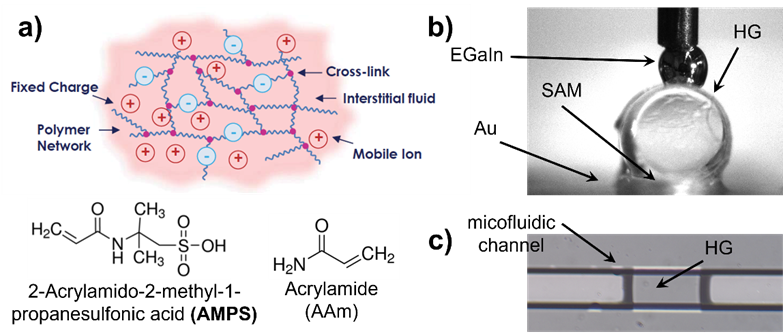Electrically conductive hydrogels for hybrid organic/inorganic devices
Supervisors: Dr. Saurabh Soni, Dr. Julieta I. Paez, Prof. dr. Christian A. Nijhuis
Biocompatible organic electronic devices are crucial for developing hardware for neuromorphic computing architecture and that can interface with living tissues and cells. Hydrogels (HGs) are soft materials with a 3D crosslinked network structure of hydrophilic polymers (schematic in figure a), which can be modulated for their ionic conductive and mechanical properties and incorporated inside solid-state devices.
In this project, we would like to utilize such HGs as oscillatory multilayers (owing to their voltage-driven reversible shrinking and expansion1), to mimic the functionality of a neuron, more specifically with the aim of fabricating oscillatory neural networks.2 HGs in which the pH can affect the ionic strength, electrical response, and (de)swelling have been demonstrated before.1 For instance, AMPS can be co-polymerized with other acrylic monomers such as AAm (Figure a) to form a HG with regulated crosslinking degree, swelling, and amount of negative charges. Upon formation and characterization of these HGs, the student will study the use of these HGs as electrode materials for electrical measurements of molecular tunneling junctions (figure b). This could also be achieved by forming composites of HG-EGaIn via published methodologies.3 The student will also work towards in situ HG formation inside microfluidic channels (figure c) for encapsulated measurements. Furthermore, the student will also investigate the current response to the voltage-driven swelling of these HGs using a liquid metal (EGaIn4) electrode. Finally, these HG-based systems would be investigated towards their possible use as memory-related (bio)organic functional devices.

During the project, the student will be exposed to some or all of the following techniques and/or instrumentations:
· Synthesis of conductive hydrogels and characterization (e.g., mechanical strength, swelling)
· Fabricating PDMS-based soft microfluidic devices
· Learning impedance and current-voltage spectroscopy
· Techniques such as template-stripping for ultraflat metal electrodes, plasma cleaning, etc.
References:
1. Kim et al., J Appl. Polym. Sci, 2004, 92, 1731–1736
2. Soman et al., Front. Comput. Neurosci. 12:52. doi: 10.3389/fncom.2018.00052
3. Fan et al., Small 2020, 16, 1903421; Xu et al., Chem. Eng. J. 2020, 392, 123788
4. Chen et al., ACS Appl. Mater. Interfaces 2019, 11 (23), 21018-21029
